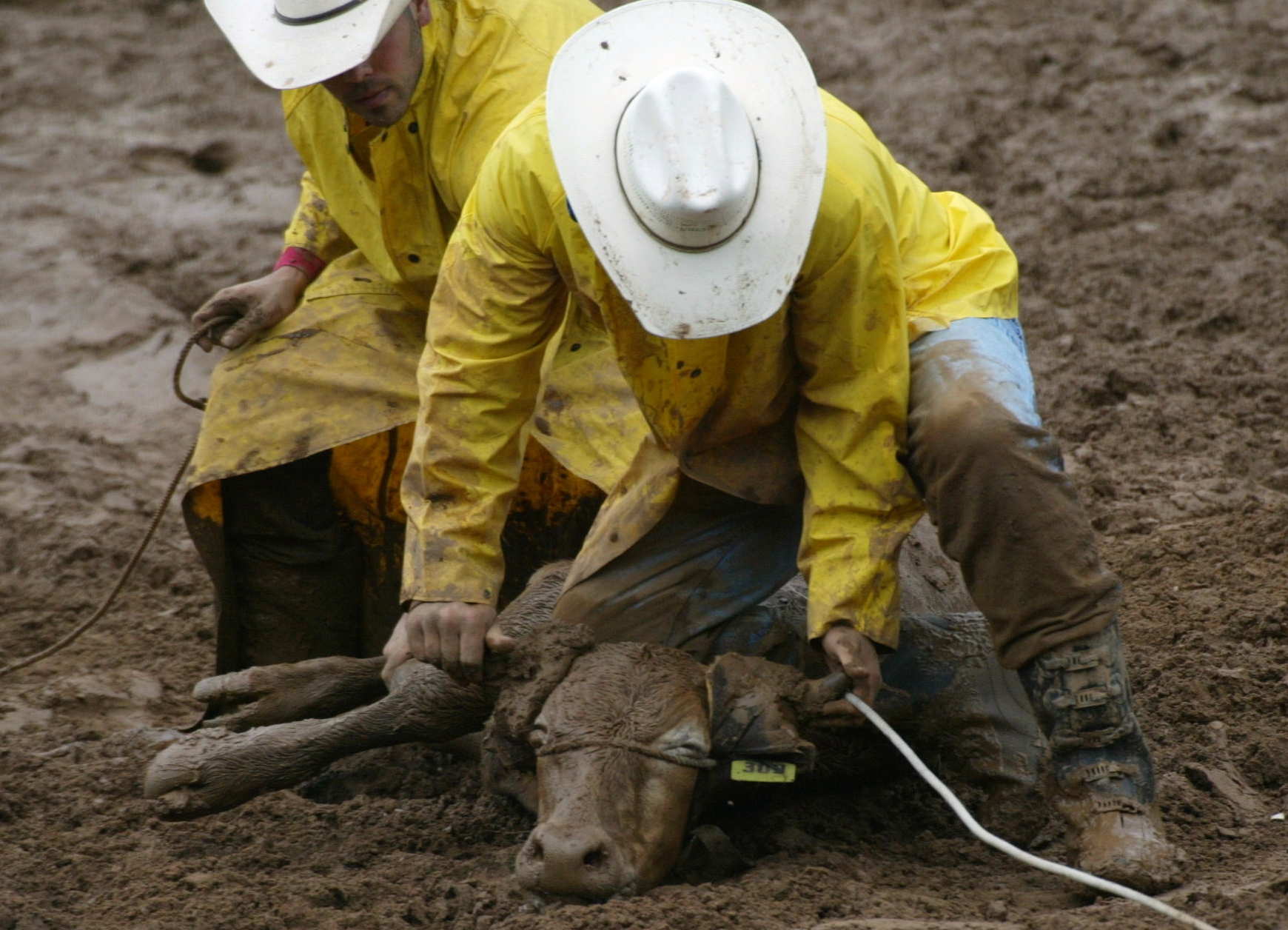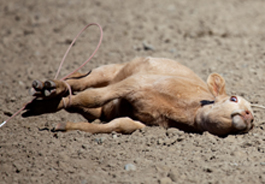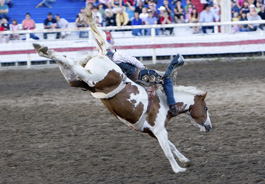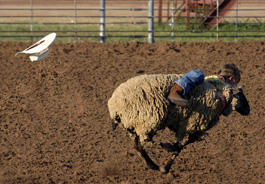I hope they do! Maybe conservative Northern Californians will all move to Texas, where they can secede and NOT get any Federal aid for anything.
LOS
ANGELES — Earlier this fall, Alameda County supervisors officially
banned the practice of “wild cow milking” — a timed event in which a
lactating beef cow, unused to human handling, has been wrangled from the
fields and brought to an arena.
There, she is separated from her calf, tossed into a rodeo ring, and
attacked by three or four men who rope her, pull her tail, wrestle her
to the ground and try to hold her still while one of them grabs her
teats and milks her.
The move comes three years after the county banned “mutton busting” —
an event in which small children are placed on the backs of scared,
unsaddled sheep and try to stay on while the sheep bucks, kicks and
jumps to knock the child off.
“It’s animal abuse,” said Eric Mills, coordinator for Oakland’s
Action for Animals, an animal welfare organization. “It’s unconscionable
to treat animals this way. Can you imagine if they did this to dogs? No
one would be OK with it. So why is it OK to do this to baby calves,
horses and cows?”
For those who admire a “western lifestyle,” a good rodeo performance
highlights the skill, bravery and strength of a talented cowboy or
cowgirl — a rider deft with a lasso, in control of wild, bucking
animals, and laser-focused on a chaotic, seemingly uncontrollable task
at hand. It’s this display of western grandeur, hard work, grit and
sportsmanship that has likely made the Peacock series “Yellowstone” such
a major hit.
But for others, the rodeo is a horror show in which terrified animals
are chased around an arena, kicked by strangers, tossed onto the ground
with potentially bone-crushing impact — all while loud music is blared
and dozens, if not hundreds, of people yell, scream and clap from the
nearby stands.
In California, there is a growing movement to ban — or seriously
curtail — these kinds of performances. And lawmakers are stepping into
the fray, exposing one more hot-button issue that is seemingly
emblematic of the nation’s growing cultural discord.
In Los Angeles, the City Council is poised to vote on legislation
that would curtail, if not eliminate, rodeo events within the city.
Instead of banning particular events, the legislation seeks to ban
certain devices used on rodeo animals — spurs, flank straps and electric
prods — that can cause pain or injury.
The legislation is sponsored by Bob Blumenfield, who represents the west San Fernando Valley.
He said he introduced the legislation because he “wanted to see what
we could do in terms of trying to make Los Angeles a little bit more
humane and live up to its name as the ‘city of angels.’”
San Francisco, San Juan Capistrano and Pasadena already have
restrictions on rodeos, as do Pittsburgh, Leesburg, Virginia, and Fort
Wayne, Indiana.
Other states, towns, counties and countries have bans on specific
events, such as the county of Baltimore, which prohibits calf roping — a
sport in which a rider mounted on a horse chases a calf around an arena
in an attempt to catch it.
At first the rider throws a rope around the neck of the small animal,
stopping it mid-run with a forceful yank, which often tops the animal
over. Then — after dismounting — the rider will try to restrain it by
tying three legs together, in as short a time as possible.
For those concerned about animal welfare and abuse, these
developments are hopeful; laying the groundwork for other counties,
municipalities and eventually the state to adopt similar restrictions.
“When Los Angeles sneezes, the whole state catches a cold,” Blumenfield said.
For rodeo supporters, however, it’s just one more example of
California’s radical progressivism — a state so out of touch with
mainstream America that it’s turning its back on a tradition as hallowed
as apple pie.
And it’s L.A.’s potential for contagion that has gotten Sean Gleason,
chief executive and commissioner of the Professional Bull Riders, or
PBR, so concerned.
“Frankly, our fans across the country have said, ‘Let them have L.A.
Who cares?’” Gleason said. “The sentiment from the rest of the country
is that they are just out there. Why even fight this fight? And my
answer to them is this is absolutely the place to fight them.”
Tim Baldwin, chairman of the Livestock Welfare Committee for the
California Rodeo Salinas — the largest rodeo in California — agreed.
“I understand that emotions run high on many issues currently, and I
hate to use the phrase ‘culture wars,’ but these ordinances tend to
stroke that division,” he said.
During an August hearing in Alameda County, rodeo proponents
suggested that the wild cow milking ban and a proposed
device-restricting ordinance were the products of extremists who sought
to cancel American culture and tradition, outlaw agriculture, and
embrace communism and Marxism.
“The fact that these bleeding hearts get on here and try, once again,
to destroy the American way of life is pathetic,” said Jackie Cota,
president of the Tri-Valley Republicans and a Livermore resident. “These
are the same people who’ve made you wear those muzzles on your mouth
right now. They want to control you for no reason and tell you there is a
deadly virus without providing you with any proof for the last two
years. They are Marxists.”
Animal activists, on the other hand, described the treatment of rodeo
animals as inhumane and violent — suggesting such events are
celebrations of domination and cruelty.
“Why are we allowing children to witness men and women forcefully
dominate and abuse animals?” asked Kristina Verdile, a tenured history
teacher who lives in Pleasanton and runs a rescue home for abused farm
animals.
While supervisors for Alameda County — home of the liberal-leaning
cities of Oakland and Berkeley — voted to prohibit wild cow milking in
the county’s unincorporated areas, they unanimously voted to amend the
ordinance and remove the device ban.
There are roughly 40 Professional Rodeo Cowboys Association events
annually throughout the state. That number doesn’t include Professional
Bull Riders events or the scores of more informal community rodeos and
charrerias, which take place almost daily throughout the summer.
Wild cow milking and mutton busting are not sanctioned at
Professional Rodeo Cowboys Association events and are not part of the
PBR format, but they are found at smaller, local rodeos, including at
Rowell Ranch, which is in unincorporated Alameda County.
“Folks sometimes underestimate the popularity of rodeo,” said
Baldwin, citing statistics showing that roughly 6.3 million people
attend professional rodeos nationally each year, and that 43 million
Americans identify as rodeo fans.
Gleason said professional bull riding is one of the fastest growing
sports in the nation and that it claims more than 82 million fans “that
watch us on television, come to our events, or engage with us
otherwise.”
Esteban Escobedo, an L.A.-based charro, can attest to the popularity.
And he’s worried about how the ordinance could affect his community. He
said although the L.A. ordinance would have minimal immediate effect —
only about a handful of charro events take place within city limits
every year — the harm would come later.
“And then what? This is our tradition. It’s our way of life,” he
said, adding that a ban would be devastating for young children and
teens who are dedicated to the sport and charro community.
Charros are Mexican horse riders, or cowboys. Events often include
dancing and rodeo performances, which can be done as a team sport, known
as a charreada, or by a solo rider.
California already regulates rodeos. Penal code Sec. 596.7 requires,
among other things, the presence of a veterinarian, or one nearby and
“on-call.” Injury reports must then be sent to the state’s veterinary
medical board. Rhode Island also requires that a vet be present or on
call, but only California demands reporting.
Requests for those reports were not immediately forthcoming. A
spokesman for the state’s Department of Consumer Affairs said that
although his agency collects this information, it has not been organized
or quantified in a way that can be summarized or released to the
public.
Baldwin and Gleason say these sports pose relatively little risk to
the animals. They say they are concerned about the safety and well-being
of their animals, and point to regulations established by the
Professional Rodeo Cowboys Assn. and PBR designed to ensure animals
aren’t injured.
“What I’m saying is, if animal rights activists were successful in
shutting down bull riding — through this argument that there’s some kind
of torture that doesn’t exist — I assure you these animals have zero
purpose and they’d be turned into hamburger within a week,” Gleason
said. “Because nobody is going to keep them around to stand around on
the farm and live a natural life.”
He said while maybe a dozen bulls have had to be euthanized in the
three decades since PBR was established, hundreds of thousands of cows
and steer die at the hands of wolves, foxes and domesticated dogs every
year. And if they don’t get felled by natural predators, they will “end
up in the food chain.”
Animal activists say such arguments are nonsense. Not only are rodeo
animals at risk of injury when they perform, but they say they are
terrorized for human entertainment.
At a Virginia bull riding event in September, a bull with a rider on
its back fell to the ground after charging out of the chute, crushing
its leg beneath its body. Video shows the animal struggling to rid
itself of the rider, bucking and kicking while its injured leg dangles
at an angle below.
And Mills, the animal rights activist from Oakland, said the reason
California legislators drafted the state’s rodeo law was because of the
large number of injuries, including a 1995 Salinas rodeo performance in
which five animals died or had to be euthanized: three horses, a steer
and a calf.
“Call it what you want,” said Matt Rossell, campaigns manager for the
Animal Legal Defense Fund. “But rodeos are nothing other than legalized
animal cruelty.”
https://www.redbluffdailynews.com/2022/11/14/is-california-on-its-way-to-banning-rodeos-behind-the-growing-movement-to-buck-the-event-2/




 iStockphoto
iStockphoto iStockphoto
iStockphoto